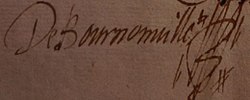Biography
Noyon
The 1612 Octo Cantica state that he was born in Noyon, but his year of birth is unknown.
Saint-Quentin
The same collection indicates him at that time as master of the children of the collegiate church of Saint-Quentin. [2] In 1613 Bournonville offered to the chapter of the Cambrai Cathedral a bound collection of his masses (probably the Parisian editions of Pierre I Ballard). [3] He remained in Saint-Quentin until about 1618. [4]
In the 1610s, he won first prizes at the puys de musique of Rouen, Évreux and Abbeville. [5]
Paris
He ended his career at the Sainte-Chapelle du Palais in Paris, where he was appointed director of the master's degree on 6 December 1631, replacing Jacques Du Moustier who died on 6 December 1631. [8] He took possession of his post on 3 January 1632, after taking an oath, and was installed "in the lower chairs on the right side, not having the order of priesthood". Offering such a position to a non-ecclesiastical musician was unusual; it can be inferred that it was his qualities that earned him such an offer. He did not work long, dying on 27 May 1632. [9]
Legacy
He was also mentioned by Annibal Gantez, in 1643: comme un Bournonville qui est mort maistre de la Saincte Chapelle, et qui a laissé son fils aussi vertueux que luy maistre de l'Église d’Amiens. [10] In addition to his son Valentin, he also had Artus Aux-Cousteaux as a student in Saint-Quentin in 1615. [11]
This page is based on this
Wikipedia article Text is available under the
CC BY-SA 4.0 license; additional terms may apply.
Images, videos and audio are available under their respective licenses.


